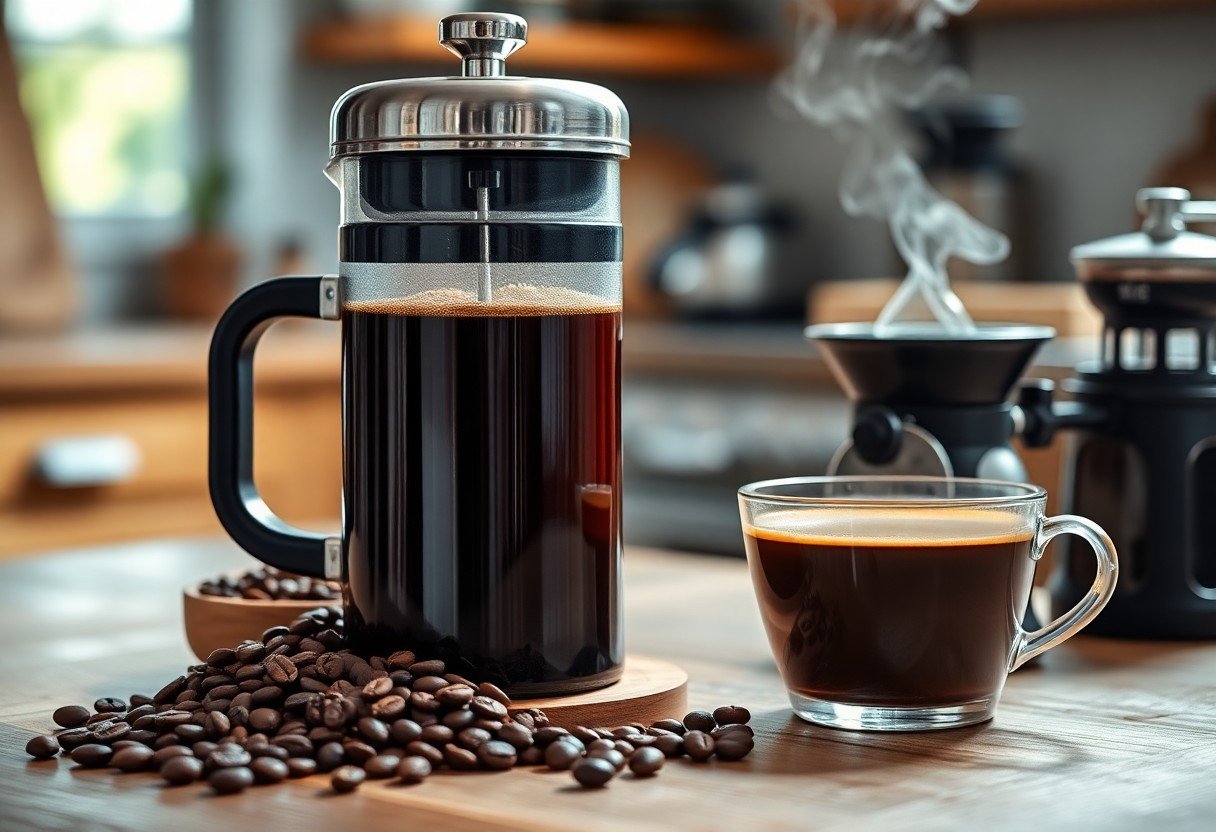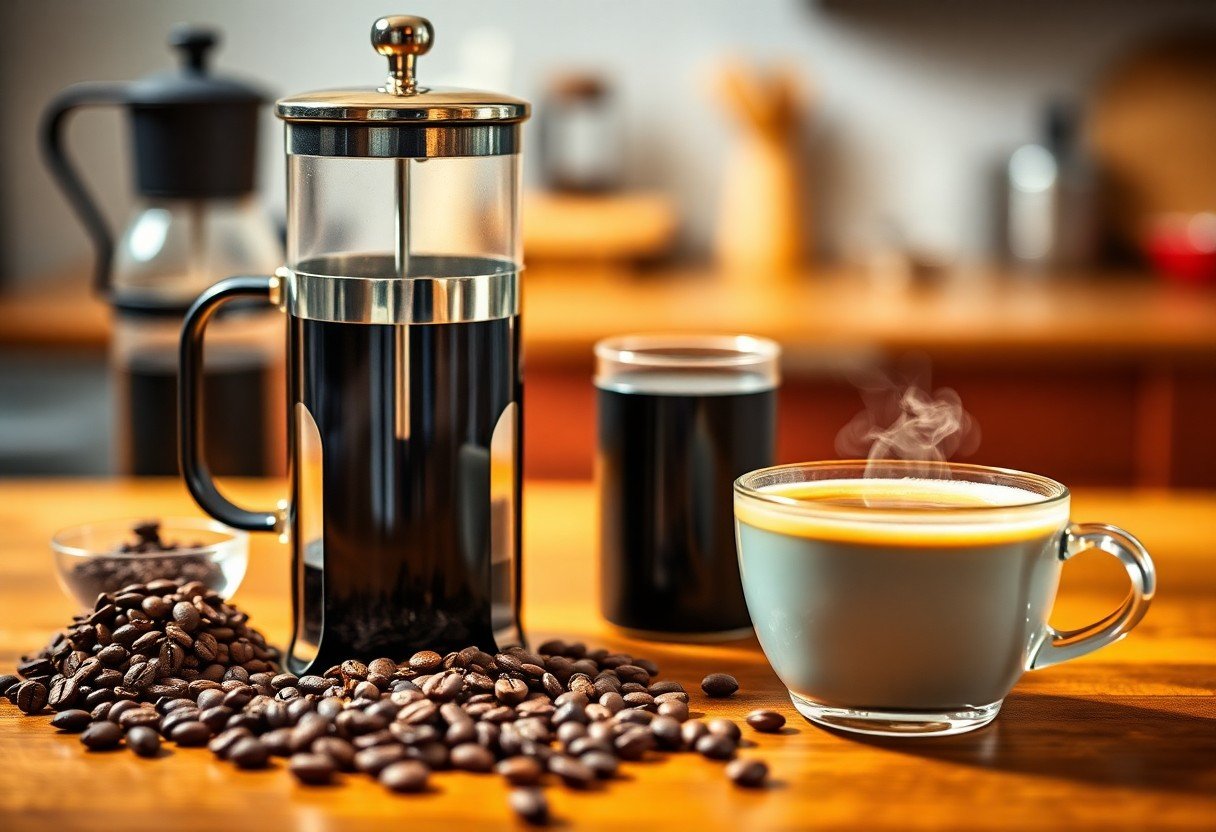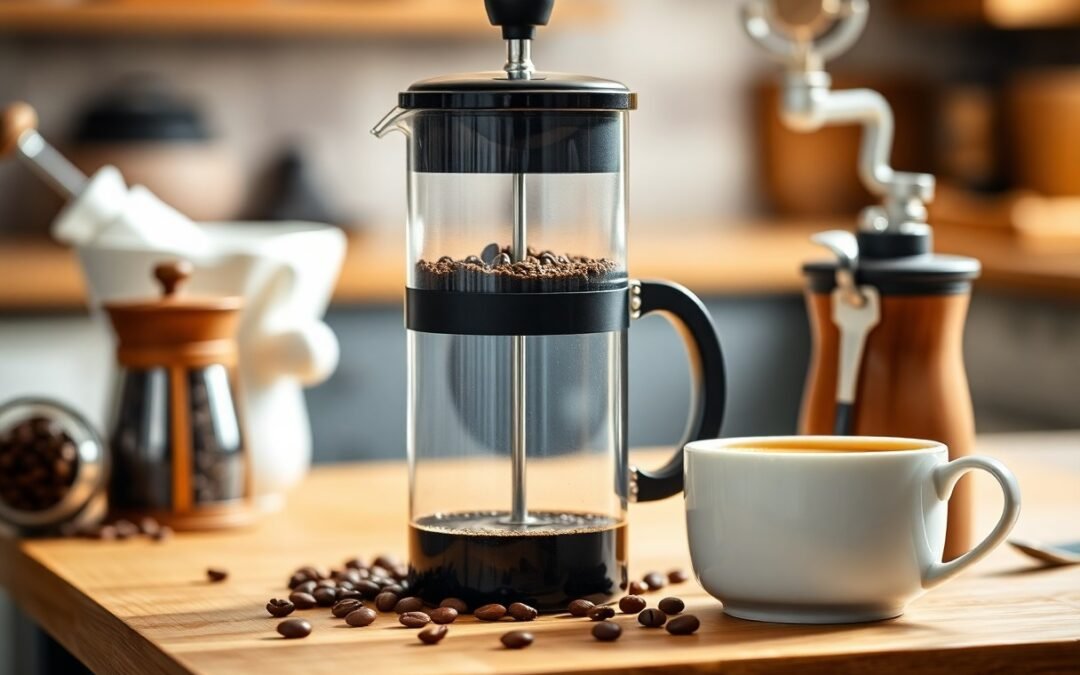This comprehensive guide will equip you with everything you need to know about brewing coffee with a French press, ensuring each cup is rich and full of flavor. By understanding the right techniques and ratios, you can elevate your brewing skills and enjoy café-quality coffee in the comfort of your home. Whether you’re a novice or a seasoned barista, you’ll find valuable tips and tricks to refine your process. For a deeper dive, check out this article on How to French Press Coffee: Mastering the Perfect Cup of ….

Selecting Your Ideal Beans
When choosing coffee beans for your French press, consider your personal taste preferences and the brewing method itself. Different beans can produce vastly different flavors, so it’s necessary to explore options that will suit your palate. Look for single-origin coffees, which often highlight distinct flavor notes from specific regions, or blends that provide a harmonious balance of flavors. Aim for a medium to coarse grind size to ensure optimal extraction, allowing you to enjoy the rich flavors your selected beans have to offer.
Exploring Coffee Varieties and Their Flavor Profiles
Diving into the world of coffee varieties unlocks a treasure trove of flavor experiences. Arabica beans tend to showcase fruity or floral notes, while Robusta beans deliver a stronger, earthy taste. Furthermore, coffees from Ethiopia may raise your taste buds with berry-like nuances, while Colombian coffees often feature a smooth, chocolatey profile—perfect for a comforting cup. By sampling various beans, you can discover which varieties align with your unique flavor preferences.
The Importance of Freshness and Roasting Dates
Freshness is a game changer in the world of coffee. Beans begin to oxidize soon after roasting, leading to a decline in flavor quality. Opt for beans roasted within the last few weeks to ensure you’re brewing with the most vibrant flavors. Check the packaging for roasting dates, and try to purchase from small roasters who focus on delivery within short timeframes to maximize the freshness in your cup.
Beans lose their peak flavor quickly, making it necessary to purchase them with a recent roasting date. The ideal consumption window usually ranges from 7 to 21 days post-roast, as the beans will continue to release carbon dioxide during the first week. Afterward, consider how you store your beans; an airtight container in a cool, dark place will help maintain their freshness for longer. Investing time in sourcing fresh, high-quality beans will greatly elevate your French press brewing experience.
Mastering Your Grind: The Key to Extraction
Achieving the perfect grind size is vital for optimal extraction in your French press. A consistent grind allows the right amount of flavor to be released during brewing, striking a balance between bitterness and acidity. Too fine a grind can lead to over-extraction and a bitter taste, while too coarse can result in under-extraction, leaving you with a weak and flavorless cup. Finding that sweet spot unlocks the rich, complex flavors of your coffee beans, ensuring a delightful experience with each sip.
The Science of Grind Size and Brewing Time
Grind size directly impacts brewing time and flavor extraction, significantly influencing your coffee’s taste profile. Finer grinds have a greater surface area, allowing them to release flavors more quickly. Conversely, coarser grinds require more time for the water to permeate and extract oils and essences. Generally, a medium-coarse grind is ideal for French press brewing, striking the right balance between time and flavor. Experimenting with grind size and timing will help you discover the unique nuances of your favorite beans.
How to Achieve a Consistent Grind at Home
Utilizing a quality burr grinder can greatly enhance your grinding consistency. Unlike blade grinders that can create uneven sizes, burr grinders crush the beans uniformly, allowing for a more controlled extraction. Adjust the settings according to your preferred grind size; for French press brewing, aim for a medium-coarse setting. Regularly cleaning your grinder will also ensure there’s no old residue impacting your fresh grind. Ultimately, investing in a reliable burr grinder is the key to enjoying better flavors and enhancing your home brewing experience.
When selecting a burr grinder, consider both manual and electric options based on your needs. Manual grinders are often more affordable and portable, while electric grinders save time and effort. Look for features such as grind size adjustment and easy cleaning mechanisms. Aim for a grinder with a reputation for durability and consistency; user reviews can provide insight into performance. By focusing on these factors, you’ll be well-equipped to create the perfect grind at home, leading to a superior cup of coffee each time you brew.
Crafting the Perfect Brew: Step-by-Step
| Step | Details |
|---|---|
| 1. Gather Your Tools | You’ll need a French press, freshly ground coffee, hot water, and a stirring utensil. |
| 2. Measure Coffee and Water | Precision in measuring coffee and water is key to achieving your desired flavor and strength. |
| 3. Heat the Water | Heat the water to just below boiling, around 200°F (93°C) for optimal extraction. |
| 4. Combine Ingredients | Add coffee grounds to the French press and pour in hot water, ensuring all grounds are saturated. |
| 5. Steep | Allow your coffee to steep for 4 minutes for the best flavor extraction. |
| 6. Press and Serve | Slowly press the plunger down and pour your brewed coffee into your cup. |
Setting Up Your French Press: Essential Tools and Techniques
Before you initiate on brewing, having the right tools will enhance your French press experience. Essential items include a high-quality French press, a burr grinder for consistent coffee grounds, a kettle for heating water, and a scale for accurate measurements. Additionally, possessing a stirring spoon can help you ensure all coffee grounds are saturated evenly, leading to an optimal brew. Setting up your environment, with fresh beans and filtered water, will further elevate the flavor profile of your coffee.
Water-to-Coffee Ratios: Finding Your Flavor Balance
Finding the right water-to-coffee ratio can transform your brewing process and define the taste of your cup. Start with a standard ratio of 1:15, which means for every gram of coffee, you’ll use 15 grams of water. Experiment with this ratio to discover your preferred strength and flavor. If you enjoy stronger coffee, consider adjusting to a 1:12 ratio. Conversely, if you prefer a milder taste, a 1:17 ratio could be ideal. Understanding how these ratios affect flavor can greatly enhance your coffee experience.
Investigating various water-to-coffee ratios allows you to customize your brew to satisfy your taste preferences. Start with the baseline and adjust based on your observations; if your coffee tastes too bitter, increase your water amount, or if it’s too weak, reduce the water. For instance, if you typically use 30 grams of coffee, start with 450 grams of water for a balanced cup, and tweak according to your results. This iterative process is key to mastering your brew and finding the perfect equilibrium that suits your individual palate.
The Art of Brewing: Technique and Timing
Precision in technique and timing transforms your French press coffee from ordinary to extraordinary. Mastering the pour, maintaining proper temperature, and manipulating brew time enables you to extract the coffee’s rich flavors while minimizing bitterness. Knowing the specific stages of the brewing process allows you to develop a nuanced approach tailored to your preferred taste. By focusing on these variables, you can refine your skills and achieve that perfect cup every time.
Infusion Methods: Different Approaches to Brewing
Infusion methods vary in their approach to brewing, allowing you to experiment and find your perfect technique. The most common method involves steeping coarsely ground coffee in hot water for a specified period. You can also explore techniques like a “twist and steep,” which incorporates gentle swirling to enhance extraction. Another option is incremental pouring, where you add your water in stages to control saturation and flavor development. Each method offers unique flavors, making exploration an exciting part of your brewing journey.
Monitoring Brew Time for Optimal Taste
Maintaining the right brew time is important for achieving a balanced and flavorful cup. Over-extraction can lead to bitterness, while under-extraction may result in a weak taste. The ideal brewing duration for a French press typically hovers around 4 minutes; however, different grind sizes or personal taste preferences might necessitate adjustments. A good rule of thumb is to experiment, noting how slight changes in time can alter your brew’s profile. This kind of attention to detail transforms your coffee-making process into an art form, ensuring a perfectly brewed cup tailored to your liking. Always keep a timer handy and refine your technique based on your findings to unlock the full potential of your beans.

Troubleshooting Common Brewing Pitfalls
Even the most skilled baristas can encounter brewing pitfalls with the French press. Understanding how to troubleshoot these issues ensures that you consistently create a memorable cup. Common challenges include undesired flavors, incorrect strength, and uneven extraction, all of which can be addressed with a bit of practice and adjustment. By becoming familiar with these irregularities, you can refine your technique and enhance your overall experience.
Identifying Over-Extracted vs. Under-Extracted Coffee
Distinguishing between over-extracted and under-extracted coffee is key to perfecting your brew. Over-extraction typically results in a bitter, harsh flavor due to excessive brewing time or overly fine grind, making your coffee taste unpleasantly astringent. On the other hand, under-extraction leaves you with sour, watery results, often stemming from an insufficient brew time or a too-coarse grind. Observing these flavor profiles can help you fine-tune your brewing method.
Tips for Adjusting Your Brew for Perfection
Achieving the perfect cup often requires small tweaks to your brewing process. Start by adjusting your grind size, as this impacts extraction; coarser grinds favor a smoother flavor, while finer grinds can lead to bitterness. Experiment with steeping time as well—if your coffee is tasting weak, extending the brew by 30 seconds may yield better results. Additionally, try altering the coffee-to-water ratio; a standard starting point is 1:15, but you might find that adjusting it to 1:12 or 1:16 suits your palate.
- Start with a basic recipe and make adjustments gradually.
- Keep notes on each adjustment to track what works best for you.
- Assume that consistency in your approach will yield the best results over time.
Documentation is your friend when it comes to achieving the ultimate brew. Keep track of each variable you change, whether it’s grind size, steep time, or water temperature. This meticulous approach allows you to identify what specifically enhances or detracts from your preferred flavor profile. Additionally, don’t shy away from experimenting with different types of coffee beans; each origin brings unique flavors that can transform your experience.
- Sample different roast levels to discover what works for you.
- Pay attention to how water temperature affects your brew.
- Assume that small changes can have a significant impact on your final cup.
Summing up
On the whole, mastering the French press allows you to elevate your coffee brewing experience significantly. By understanding the vitals of coffee-to-water ratios, grind size, and brewing time, you can achieve a rich and flavorful cup tailored to your taste. With practice and experimentation, you will gain confidence in your technique, ultimately enhancing your appreciation for this classic method. Embrace the process, and enjoy the art of brewing the perfect cup of coffee with your French press.
FAQ
Q: What are the key steps to brewing coffee using a French press?
A: Brewing coffee with a French press involves several key steps. First, start by coarsely grinding fresh coffee beans. A general guideline is to use one tablespoon of coffee for every six ounces of water, but you can adjust based on your taste preference. Next, heat water to just below boiling, around 200°F (93°C). Combine the coffee grounds and hot water in the French press, ensuring all grounds are saturated. Stir gently and let it steep for about four minutes. Finally, slowly press down the plunger to separate the grounds from the liquid and pour your freshly brewed coffee into your cup, enjoying it immediately for the best flavor.
Q: How does grind size affect the flavor of my French press coffee?
A: Grind size greatly impacts the extraction of flavors during brewing. For French press, a coarse grind is ideal because it allows for optimal extraction without over-extracting the coffee, which can lead to bitterness. If the grind is too fine, it can clog the mesh filter and result in a gritty texture or an overly bitter taste. Coarse grounds also help to preserve the crucial oils and nuances of the coffee, delivering a richer and more aromatic cup. Experimenting with different grind sizes can help you find the balance that produces your preferred flavor profile.
Q: Can I use different types of coffee beans for French press brewing?
A: Absolutely! The French press is versatile and works well with a variety of coffee beans, from single-origin to blends, and different roast levels ranging from light to dark. Each type of bean brings its own unique flavors and characteristics. Lighter roasts tend to highlight floral and fruity notes, while medium to dark roasts often have bolder, richer flavors. It’s a great opportunity to explore different origins and roasts to discover what satisfies your palate. Just make sure to adjust the grind size and coffee-to-water ratio according to the bean type for the best results.

